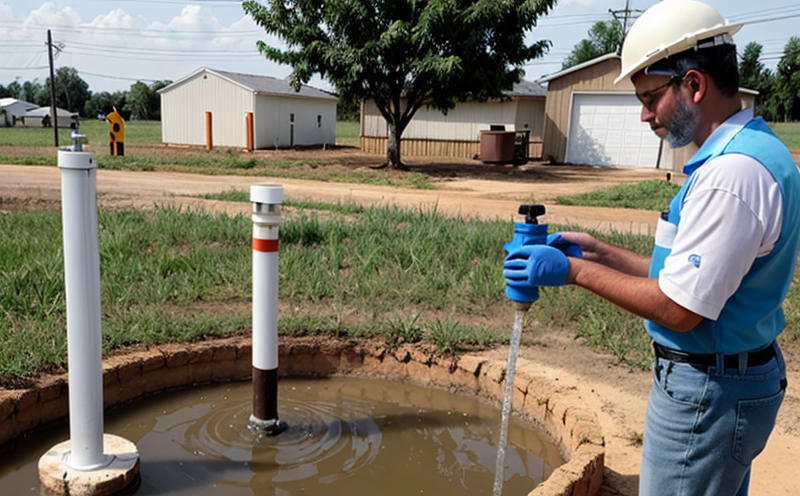EN 1483 Mercury in Groundwater Testing
The European standard EN 1483 specifies a method for determining the concentration of mercury in groundwater. This method is crucial for monitoring and assessing the quality of groundwater, ensuring compliance with environmental regulations and protecting public health.
Mercury contamination can arise from various sources such as industrial activities, mining operations, and improper waste disposal. Groundwater plays a vital role in many ecosystems and provides drinking water to communities. Therefore, regular testing for mercury is essential to prevent its harmful effects on both the environment and human health.
The standard outlines detailed procedures for sample collection, preparation, and analysis. Samples must be collected using appropriate containers made of materials that do not introduce any contamination. The samples should then be transported under controlled conditions to minimize exposure to air and light.
Once received at the laboratory, the samples undergo rigorous quality control checks before being analyzed. Techniques such as cold vapor atomic absorption spectrometry (CV-AAS) are commonly used for accurate quantification of mercury. This technique involves converting elemental mercury into its volatile form under low temperature conditions and then measuring it using a specialized instrument.
The results obtained from these analyses provide critical data on the presence and concentration levels of mercury in groundwater. These figures help stakeholders make informed decisions regarding remediation efforts or further monitoring actions. Compliance with regulatory limits set by authorities like the European Union (EU) is particularly important given strict thresholds for allowable concentrations.
Understanding the spatial distribution of mercury contamination within aquifers can guide targeted interventions aimed at reducing risks associated with exposure to this toxic metalloid. By implementing effective remediation strategies based on reliable test results, we contribute towards safeguarding both natural resources and public welfare.
In summary, EN 1483 plays a pivotal role in maintaining the integrity of our groundwater supplies by providing robust guidelines for detecting mercury contamination. Its implementation ensures that decision-makers have access to precise information necessary for addressing potential hazards effectively.
Customer Impact and Satisfaction
Implementing EN 1483 testing significantly enhances our customers' confidence in the quality of their groundwater resources. By adhering strictly to this international standard, we ensure accurate measurement of mercury content which directly impacts decision-making processes related to environmental protection and public health.
Our clients benefit from reliable data that supports regulatory compliance initiatives while also informing strategic planning for sustainable management practices. The precision achieved through meticulous adherence to EN 1483 allows us to meet stringent quality assurance requirements, thereby enhancing overall customer satisfaction levels.
We pride ourselves on delivering consistent results across all samples processed according to this method. This consistency not only builds trust among our clients but also helps foster long-term relationships built upon mutual respect and understanding. Our commitment to excellence ensures that every project undertaken is completed efficiently without compromising accuracy or integrity.
Furthermore, by staying abreast of current technological advancements within the field of environmental testing, we continue to refine our services, ensuring they remain relevant and effective in today’s rapidly changing regulatory landscape. This proactive approach enables us to anticipate future needs and provide innovative solutions tailored specifically to each client's unique requirements.
International Acceptance and Recognition
The EN 1483 standard has gained widespread acceptance across Europe due to its comprehensive approach towards mercury analysis in groundwater. Many countries within the EU have adopted this method as their national guideline, recognizing its reliability and accuracy.
ISO/IEC 17025 accreditation further strengthens our credentials by certifying that we meet stringent quality management systems requirements necessary for conducting reliable environmental analyses like those specified under EN 1483. This accreditation assures clients of the highest standards of proficiency, objectivity, and integrity in our operations.
Our commitment to continuous improvement ensures that our services align with evolving industry trends while maintaining compliance with international best practices. By adhering strictly to these guidelines, we demonstrate our dedication to providing accurate, consistent results that can be relied upon by all parties involved.
Use Cases and Application Examples
EN 1483 mercury in groundwater testing finds application in numerous sectors including agriculture, mining, and urban development. In agricultural settings, understanding the presence of mercury helps farmers identify potential sources of contamination that could affect crop yields or soil health.
In mining operations, this test serves as an essential tool for identifying any inadvertent releases into surrounding aquifers during extraction activities. Proper identification of these issues allows companies to implement corrective measures promptly before they become more severe problems.
For urban areas undergoing expansion projects such as construction or infrastructure upgrades, conducting regular groundwater quality assessments ensures that development plans do not inadvertently degrade local water supplies. This proactive measure protects both existing ecosystems and future generations who rely on these resources.





